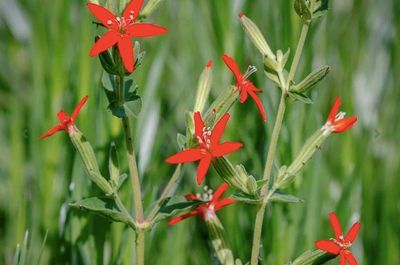Signed in as:
filler@godaddy.com
Signed in as:
filler@godaddy.com

The sepals are green (sometimes covered with sticky glands) and the petals are usually an intense shade of crimson. Sometimes they may be a dull red, very rarely pinkish, or even white. The stigmas and anthers develop at different times, preventing any given flower from self-pollination.
The fruit is a capsule, opening at the top. The capsules begin ripening in late August, and most seed falls in September and October. The seeds disperse as the stems holding the capsules are shaken by the wind.
The leaves are entire and opposite, up to 7 centimeters long. Royal Catchfly plants may be smooth but more often have a covering of very short hairs; the stems and leaves are usually green, but sometimes the stems develop a purplish tinge.
Royal catchfly occurs in prairies, savannas, barrens, and open woodlands, usually on well-drained, often rocky soils.
Royal Catchfly is one of a small number of red-flowered plants native to the Midwest, and one of very few, red-flowered, prairie plants.
Royal Catchfly is one of the very few prairie plants pollinated by hummingbirds.
****Only one species of hummingbird occurs regularly within the range of Royal Catchfly – the ruby-throated hummingbird (Archilochus colubris). Try to use your scientist skills to catch a glimpse of a ruby-throated hummingbird in the pollinator garden.
Cooking help us understand and optimize your orchard website experience. By accepting the use of cookies, your data will be aggregated with other user data.